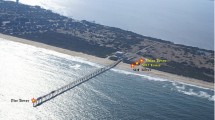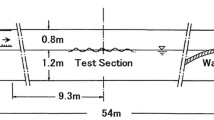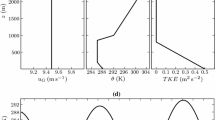Abstract
The coastal discontinuity imposes strong signals to the atmospheric conditions over the sea that are important for wind-energy potential. Here, we provide a comprehensive investigation of the influence of the land–sea transition on wind conditions in the Baltic Sea using data from an offshore meteorological tower, data from a wind farm, and mesoscale model simulations. Results show a strong induced stable stratification when warm inland air flows over a colder sea. This stratification demonstrates a strong diurnal pattern and is most pronounced in spring when the land–sea temperature difference is greatest. The strength of the induced stratification is proportional to this parameter and inversely proportional to fetch. Extended periods of stable stratification lead to increased influence of inertial oscillations and increased frequency of low-level jets. Furthermore, heterogeneity in land-surface roughness along the coastline is found to produce pronounced horizontal streaks of reduced wind speeds that under stable stratification are advected several tens of kilometres over the sea. The intensity and length of the streaks dampen as atmospheric stability decreases. Increasing sea surface roughness leads to a deformation of these streaks with increasing fetch. Slight changes in wind direction shift the path of these advective streaks, which when passing through an offshore wind farm are found to produce large fluctuations in wind power. Implications of these coastline effects on the accurate modelling and forecasting of offshore wind conditions, as well as damage risk to the turbine, are discussed.
















Similar content being viewed by others
References
Baas P, Bosveld F, Holtslag A (2009) A climatology of nocturnal low-level jets at Cabauw. J Appl Meteorol 48:1627–1642. doi:10.1175/2009JAMC1965.1
Barthelmie R, Badger J, Pryor S, Hasager CB, Christiansen MB, Jørgensen B (2007) Offshore coastal wind speed gradients: issues for the design and development of large offshore windfarms. Wind Eng 31(6):369–382. doi:10.1260/030952407784079762
Bergström H (2001) Boundary-layer modelling for wind climate estimates. Wind Eng 25(5):289–299. doi:10.1260/030952401760177864
Csanady G (1974) Equilibrium theory of the planetary boundary layer with an inversion lid. Boundary-Layer Meteorol 6(1–2):63–79. doi:10.1007/BF00232477
Donlon CJ, Martin M, Stark J, Roberts-Jones J, Fiedler E, Wimmer W (2012) The operational sea surface temperature and sea ice analysis (ostia) system. Remote Sens Environ 116:140–158. doi:10.1016/j.rse.2010.10.017
Doran J, Gryning SE (1987) Wind and temperature structure over a land–water–land area. J Appl Meteorol 26:973–979. doi:10.1175/1520-0450(1987)026<0973:WATSOA>2.0.CO;2
Dörenkämper M, Tambke J, Steinfeld G, Heinemann D, Kühn M (2014) Atmospheric impacts on power curves of multi-megawatt offshore wind turbines. J Phys 555:012029. doi:10.1088/1742-6596/555/1/012029
Draxl C, Hahmann AN, Peña A, Giebel G (2014) Evaluating winds and vertical wind shear from weather research and forecasting model forecasts using seven planetary boundary layer schemes. Wind Energy 17:39–55. doi:10.1002/we.1555
Emeis S (2010) A simple analytical wind park model considering atmospheric stability. Wind Energy 13(5):459–469. doi:10.1002/we.367
EWEA (2013) Deep water—the next step for offshore wind energy. Technical Report. European Wind Energy Association, Brussels, 51 pp
EWEA (2014) The european offshore wind industry—key trends and statistics 2013. Technical Report. European Wind Energy Association, Brussels, 22 pp
FINO2 (2007) FINO2 measurement platform—installation protocol. Technical Report. Wind Consult, 152 pp
Foreman RJ, Emeis S (2012) A method for increasing the turbulent kinetic energy in the Mellor–Yamada–Janjić boundary-layer parametrization. Boundary-Layer Meteorol. 145(2):329–349 doi:10.1007/s10546-012-9227-4
Foreman RJ, Emeis S, Canadillas B (2015) Half-order stable boundary-layer parametrization without the eddy viscosity approach for use in numerical weather prediction. Boundary-Layer Meteorol. 154(2):207–228 doi:10.1007/s10546-014-9969-4
Grisogono B, Tjernström M (1996) Thermal mesoscale circulations on the Baltic coast: 2. Perturbation of surface parameters. J Geophys Res 101(D14):18999–19012. doi:10.1029/96JD01207
GWEC (2013) Global wind report, annual market update 2013. Technical Report. Global Wind Energy Council, Brussels, 80 pp
Hansen KS, Barthelmie RJ, Jensen LE, Sommer A (2012) The impact of turbulence intensity and atmospheric stability on power deficits due to wind turbine wakes at Horns Rev wind farm. Wind Energy 15:183–196. doi:10.1002/we.512
Hasager CB, Badger M, Peña A, Larsén XG, Bingöl F (2011) SAR-based wind resource statistics in the Baltic Sea. Remote Sens 3(1):117–144. doi:10.3390/rs3010117
Hong SY, Noh Y, Dudhia J (2006) A new vertical diffusion package with an explicit treatment of entrainment processes. Mon Weather Rev 134(9):2318–2341. doi:10.1175/MWR3199.1
Lange B, Larsen S, Højstrup J, Barthelmie R (2004) Importance of thermal effects and sea surface roughness for offshore wind resource assessment. J Wind Eng Ind Aerodyn 92(11):959–988. doi:10.1016/j.jweia.2004.05.005
Mellor GL, Yamada T (1982) Development of a turbulence closure model for geophysical fluid problems. Rev Geophys Space Phys 20(4):851–875. doi:10.1029/RG020i004p00851
Nakanishi M, Niino H (2004) An improved Mellor–Yamada level-3 model with condensation physics: its design and verification. Boundary-Layer Meteorol 112:1–31. doi:10.1023/B:BOUN.0000020164.04146.98
NCEP (2011) NCEP climate forecast system version 2 (CFSv2) selected hourly time-series products. Technical Report. Environmental Modeling Center/National Centers for Environmental Prediction/National Weather Service/NOAA/U.S. Department of Commerce, Research Data Archive at the National Center for Atmospheric Research, Computational and Information Systems Laboratory, Boulder (updated monthly). http://rda.ucar.edu/datasets/ds094.1/
Peña A, Hahmann A, Hasager C, Bingöl F, Karagali I, Badger J, Badger M, Clausen N (2011) South Baltic wind atlas. Technical Report. Ris-R-1775(EN), Technical University of Denmark, 66 pp
Pleim JE (2007) A combined local and nonlocal closure model for the atmospheric boundary layer. Part I: Model description and testing. J Appl Meteorol Clim 46(9):1383–1395. doi:10.1175/JAM2534.1
Pryor S, Barthelmie R (1998) Analysis of the effect of the coastal discontinuity on near-surface flow. Ann Geophys 16(7):882–888. doi:10.1007/s00585-998-0882-3
Sathe A, Gryning SE, Peña A (2011) Comparison of the atmospheric stability and wind profiles at two wind farm sites over a long marine fetch in the North Sea. Wind Energy 14(6):767–780. doi:10.1002/we.456
Skamarock W, Klemp J, Dudhia J, Gill D, Barker D, Duda M, Huang X, Wang W, Powers J (2008) A description of the advanced research WRF version 3. Technical Report. NCAR/TN475+STR, NCAR—National Center for Atmospheric Research, Boulder, 125 pp. doi:10.5065/D68S4MVH
Smedman AS (1991) Occurrence of roll circulations in a shallow boundary layer. Boundary-Layer Meteorol 57(4):343–358. doi:10.1007/BF00120053
Smedman AS, Högström U, Bergström H (1996) Low level jets—a decisive factor for off-shore wind energy siting in the Baltic Sea. Wind Eng 20(3):137–147
Smedman AS, Bergström H, Grisogono B (1997) Evolution of stable internal boundary layers over a cold sea. J Geophys Res 102(C1):1091–1099. doi:10.1029/96JC02782
Tjernström M, Grisogono B (1996) Thermal mesoscale circulations on the Baltic coast: 1. Numerical case study. J Geophys Res 101(D14):18979–18997. doi:10.1029/96JD01201
Tjernström M, Smedman AS (1993) The vertical turbulence structure of the coastal marine atmospheric boundary layer. J Geophys Res 98(C3):4809–4826. doi:10.1029/92JC02610
Vincent CL, Larsén XG, Larsen SE, Sørensen P (2013) Cross-spectra over the sea from observations and mesoscale modelling. Boundary-Layer Meteorol 146:297–318. doi:10.1007/s10546-012-9754-1
Acknowledgments
The work presented in this study is funded by the National Research Project Baltic 1 (FKZ0325215A, Federal Ministry for Environment, Nature Conservation and Nuclear Safety) and the Ministry for Education, Science and Culture of Lower Saxony. The DAAD is thanked for granting Martin Dörenkämper a 2-month stay at the University of Victoria, Victoria, BC, Canada. Adam Monahan and Michael Optis acknowledge the support of the Natural Science and Engineering Research Council of Canada through the Discovery Grant Program and the CREATE Training Program in Interdisciplinary Climates Science. The authors thank the Project Management Jülich (PTJ) and the Federal Maritime And Hydrographic Agency (BSH) for providing access to the data of the offshore research platform FINO2. The authors thank Yuko Takeyama for discussions on wind-speed streaks in coastal areas. The authors are grateful to Sonja Drüke, Robert Günther and Stefan Albensoeder for their help in setting up the WRF model.
Author information
Authors and Affiliations
Corresponding author
Appendix: On the Influence of the PBL Scheme on Wind Conditions in Stable Stratification
Appendix: On the Influence of the PBL Scheme on Wind Conditions in Stable Stratification
To investigate the influence of the PBL scheme on the streaks described in Sect. 3.2.1, the simulations for 23 July 2012 were repeated with four different PBL schemes. Figure 17 shows hub-height fields of wind speed as in Fig. 11d obtained from the WRF model for four different PBL schemes: Mellor–Yamada–Nakanishi–Niino (MYNN) (a) (Nakanishi and Niino 2004), Yonsei-University (YSU) (c) (Hong et al. 2006) and Asymetric Convective Model version 2 (ACM) (d) (Pleim 2007). In addition we also implemented a recent suggested modification of the Mellor–Yamada–Janjić (MYJv2) scheme (Foreman and Emeis 2012) for more accurate wind-energy forecasts into the WRF model (b). All other parametrization schemes were defined as described in Sect. 2.2.
Hub-height fields (\(z\) = 67 m) of wind speed for four different PBL schemes [a Mellor–Yamada–Nakanishi–Niino, b Mellor–Yamada–Janjić modified after Foreman and Emeis (2012), c Yonsei University, d Asymmetric Convective Model version 2] obtained from WRF model simulations during stable offshore conditions on 23 July 2012 at 1200 UTC (hourly averages). The grey shaded triangle marks the position and extent of the wind farm
The results show that streaks are detectable in all of the PBL schemes chosen. The intensity of the streaks is stronger and the length of the streaks greater with the YSU and ACM parametrizations and slightly weaker in the MYNN and MYJv2 schemes. Location and origin of the streaks (patches of high roughness on the Darß-Zingst peninsula) are the same for all parametrizations chosen. The wind field simulated with the MYNN (Fig. 17a) scheme shows a stronger deflection of the flow towards the right at the coastal passage and a weakened afterwards, while the deviations are comparable for all other schemes. Generally the wind speeds tend to be higher in the MYNN and MYJv2 schemes, while they are slightly lower in the ACM and YSU schemes. In summary, it can be stated that there is no large influence of the PBL scheme on the occurrence of roughness-induced streaks of low wind speeds.
Rights and permissions
About this article
Cite this article
Dörenkämper, M., Optis, M., Monahan, A. et al. On the Offshore Advection of Boundary-Layer Structures and the Influence on Offshore Wind Conditions. Boundary-Layer Meteorol 155, 459–482 (2015). https://doi.org/10.1007/s10546-015-0008-x
Received:
Accepted:
Published:
Issue Date:
DOI: https://doi.org/10.1007/s10546-015-0008-x





